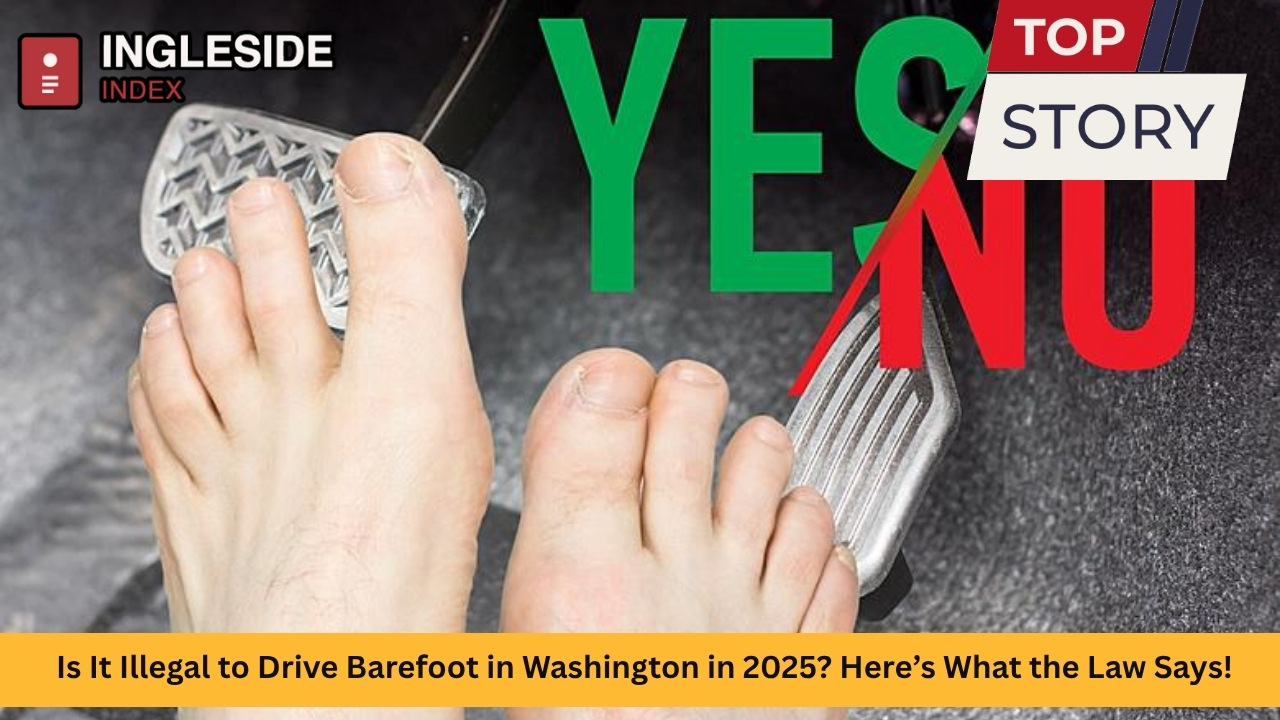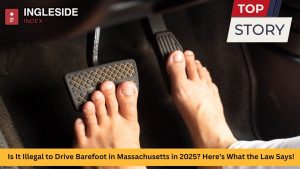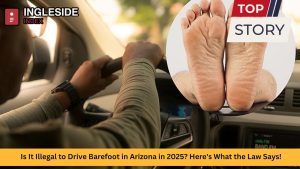Driving norms create endless debates and urban myths, especially when it comes to lifestyle choices behind the wheel. One such topic that sparks curiosity in communities across Washington State—from the bustling avenues of Seattle and Tacoma to the peaceful roads of Spokane and Bellingham—is the legality and safety of driving barefoot. In 2025, as Washington introduces new traffic legislation, many are wondering: Can you legally drive barefoot in Washington, and what are the actual consequences if you choose to do so?
This comprehensive guide dives deep into the laws, myths, safety implications, and real-world statistics surrounding barefoot driving in the Evergreen State.
Understanding the Law: What Washington Says About Barefoot Driving
Washington State law does not prohibit driving barefoot. This means that whether you’re cruising through the vibrant streets of Olympia, exploring scenic routes near Yakima, or rolling along the coastlines of Everett, you won’t find any statute on the books making it a traffic offense to drive without shoes.
In fact, as of 2025, there is no state in the U.S.—including Washington—that makes barefoot driving explicitly illegal. The belief that you can be ticketed just for being shoeless while operating a vehicle is a myth that has persisted for decades. This misconception often circulates among new drivers and even appears in casual conversations among experienced motorists across cities like Vancouver and Federal Way.
How Localities and New Laws Influence Driving Practices
While the statewide law is clear, local jurisdictions and new statutes coming into effect can sometimes muddy the waters. In 2025, Washington rolled out a new law enhancing penalties for negligent driving, especially where pedestrians and cyclists are involved. This law targets negligent behavior that leads to injury or fatality but does not specifically address barefoot driving.
Police departments in cities such as Redmond, Bellevue, and Kennewick confirm that there is no city ordinance prohibiting barefoot driving. However, if being barefoot results in a loss of vehicle control leading to an accident—for example, slipping off the brake or gas pedal—officers have the authority to cite the driver for negligent or reckless driving.
Myths and Misconceptions: Where Did the Barefoot Driving Myth Start?
The myth that driving barefoot is illegal likely stems from well-intentioned safety advice passed down through generations. Many parents across Washington have reminded teenage drivers in places like Issaquah and Wenatchee to “put on your shoes before you leave.” Some driver’s education instructors have cautioned that certain types of footwear, or the lack thereof, could impede safe driving. Over time, these reminders have mutated into a widespread, but inaccurate, belief that the law itself restricts barefoot driving.
Safety Implications: Is Driving Barefoot More Dangerous?
While legal, driving barefoot does present safety considerations—some subtle and some significant. According to studies and the National Highway Traffic Safety Administration (NHTSA) data, the main risks associated with barefoot driving include:
-
Reduced traction: Bare feet are more prone to slipping, particularly if the pedals are wet or dirty. This can result in slower reaction times, especially in emergencies.
-
Inconsistent pressure: Shoes provide a consistent surface and distribute force evenly. Bare feet, by contrast, may not apply the same uniform pressure, which can be critical in sudden braking scenarios whether you are in Seattle traffic or merging onto I-5.
-
Increased injury risk: Feet are susceptible to injuries from unseen objects on the car floor, or exposure to metal pedals during extreme summer heat in cities like Richland or Spokane Valley.
Data Spotlight: A national survey from the NHTSA estimated that failure to apply the brakes properly is a factor in roughly 2% of at-fault collisions each year. While specific data on barefoot drivers in Washington is sparse, safety experts advise that wearing well-fitted footwear can help reduce a preventable risk.
Barefoot vs. Flip-Flops and Other Risky Footwear
Interestingly, some experts argue that driving barefoot might be SAFER than driving in flip-flops, high heels, or other loose footwear, as these can get stuck under the pedals. During Washington’s warm months, drivers from places like Kelso and Moses Lake often slip off their sandals or flip-flops to drive barefoot after trips to the beach or lakeside parks.
A 2022 traffic study in Tacoma indicated that loose footwear contributes to minor driving mishaps in nearly 7% of reported near-miss incidents, primarily during the summer months. In comparison, there are no major reports directly tying barefoot driving alone to increased accident rates.
Insurance and Liability: What Happens After an Accident?
The legality of barefoot driving doesn’t always safeguard you from complications following a crash. If a barefoot driver is involved in an accident in cities like Renton, Marysville, or Pullman, insurance investigators may factor in footwear if there’s evidence that being shoeless contributed to negligence. In such scenarios, claims could be denied or compensation reduced, especially if there’s a dispute over driver control or reasonable behavior.
New traffic regulations in 2025—especially laws targeting negligent driving—mean that courts in regions like Pierce or King County could consider being barefoot as an element in cases where driver conduct is questioned following a serious crash involving pedestrians or cyclists.
Common Scenarios: What Happens on the Ground?
Let’s look at some practical examples across Washington cities:
-
Seattle: A commuter leaves the gym, slipping off sweaty shoes and driving home barefoot. Legally, they’re fine. But if they lose control in downtown traffic, police could cite them for negligent driving if improper pedal control was a factor in an accident.
-
Spokane: A parent grabs flip-flops or goes barefoot after a day at Riverfront Park. A minor fender-bender occurs. Barefoot driving alone isn’t a violation, but if cited as a cause for the driver’s inattention, insurance complications might follow.
-
Tacoma: A rideshare driver keeps a spare pair of sneakers in the back seat after a passenger’s dog makes a mess. This proactive step minimizes liability if an accident occurs, since insurance companies ask if proper footwear was used.
How the Law Might Change: Will Future Legislation Target Barefoot Driving?
As of mid-2025, there are no bills or proposed regulations in the Washington State Legislature aiming to prohibit barefoot driving. However, as car safety technology continues to evolve, lawmakers could revisit traffic regulations, especially if injury or accident data prompts new studies. Until then, only specific acts—like reckless or negligent driving that directly causes harm—can lead to legal consequences, regardless of footwear.
Real Statistics: Washington Traffic Trends, Footwear, and Road Safety
Washington’s Department of Transportation reports nearly 82,000 reported traffic collisions statewide in 2024, the vast majority involving issues other than driver footwear. Among factors investigated in major accidents, common causes include distracted driving, impaired driving, and exceeding speed limits—not barefoot driving. Although statistical breakdowns by footwear are rare, there is no surge in incidents directly attributable to bare feet behind the wheel in cities like Yakima or Tri-Cities.
Recent updates from the Washington Traffic Safety Commission emphasize that the best practices for drivers continue to revolve around alertness, preparation, and responsible choices—regardless of their shoes or lack thereof.
Tips for Safe Driving: Recommendations for Every Washington Motorist
Whether you’re driving barefoot, in boots, or in your favorite sneakers, here’s how to ensure safety on the road:
-
Keep non-slip shoes handy: Store a spare pair in your vehicle, especially if you frequently drive after swimming, hiking, or exercise.
-
Check for obstacles: Make sure the footwell is free from debris, loose objects, or slippery floor mats that could interfere with pedal operation.
-
Adjust for weather and terrain: Remember, icy winters in Spokane Valley or rainy days in Aberdeen make proper footwear even more important for grip and pedal reaction.
-
Know your insurance policy: If you’re involved in a crash, be prepared to answer questions about driving conditions—including your footwear.
Frequently Asked Questions About Barefoot Driving in Washington
Can I be pulled over in Seattle or Tacoma for driving barefoot?
No law prohibits the act. Officers can only cite you for related driving infractions if lack of footwear directly contributes to another violation.
What about motorcycles or commercial drivers?
Motorcycle operators must follow specific gear guidelines for safety, but there is no explicit law demanding shoes for passenger vehicle drivers, including commercial ones.
Are there any exceptions in small towns or rural areas?
To date, even smaller towns with unique municipal codes do not have reported statutes restricting barefoot driving in regular passenger vehicles.
Wrapping Up: Barefoot Driving—Legal, But Is It Smart?
Driving barefoot in Washington State is legal, but not always advisable. The existing law is clear, yet practical wisdom and safe driving habits remain paramount. While there’s no risk of a ticket solely for having bare feet at the wheel in Olympia, Everett, or Pasco, the ripple effects of risky driving behaviors—negligence, loss of control, and increased insurance scrutiny—are real.
As Washington’s roads continue to evolve along with technology and new transportation policies, staying educated and adopting safe habits—no matter which city you call home—remains your best defense on the road.
Table: Barefoot Driving Quick Facts in Washington
| Category | Status (2025) | Impact |
|---|---|---|
| State Law | Legal | No ticket for barefoot driving |
| Local Ordinances | No bans in major cities | Uniform with state law |
| Insurance | Barefoot may be a risk factor | Possible claims complications |
| Safety | Not recommended | Grip, control, injury risk |
| Stats | No spike linked to barefoot | Accidents more from other causes |
Whether you’re navigating city streets in Seattle or winding through the orchards in Wenatchee, the key takeaway in 2025 is clear: you can drive barefoot, but safety—and prudence—should always come first.
- https://www.pendergastlaw.com/blog/2024/10/what-are-the-dangers-of-driving-barefoot/
- https://www.superlawyers.com/resources/traffic-violations/driving-barefoot-is-it-legal/
- https://kw3.com/safe-footwear-for-driving-safety/
- https://www.heraldnet.com/news/yes-it-is-legal-to-drive-barefoot-but-should-you/
- https://kpq.com/ixp/1137/p/safe-footwear-for-driving-safety/
- https://wsp.wa.gov/driver/rules-of-the-road/
- https://keyw.com/washington-barefoot-driving/
- https://www.directauto.com/learning-center/driving-laws-and-safety/is-it-illegal-to-drive-barefoot
- https://dol.wa.gov/media/pdf/61/driverguide-enpdf/download?inline
- https://www.kiro7.com/news/local/new-wa-law-aims-protect-vulnerable-road-users-with-harsher-penalties-negligent-drivers/YIB56BLGBVHPVAOT3OJJSDTM3E/
- https://www.reddit.com/r/todayilearned/comments/19475rx/til_the_only_state_in_the_us_that_requires_shoes/
- https://regulations.justia.com/states/washington/title-308/chapter-308-104/section-308-104-006/
- https://insurify.com/car-insurance/knowledge/is-it-illegal-to-drive-barefoot/
- https://app.leg.wa.gov/rcw/default.aspx?cite=46.20.015
- https://gelbandgelb.com/is-it-illegal-to-drive-barefoot-in-dc/




